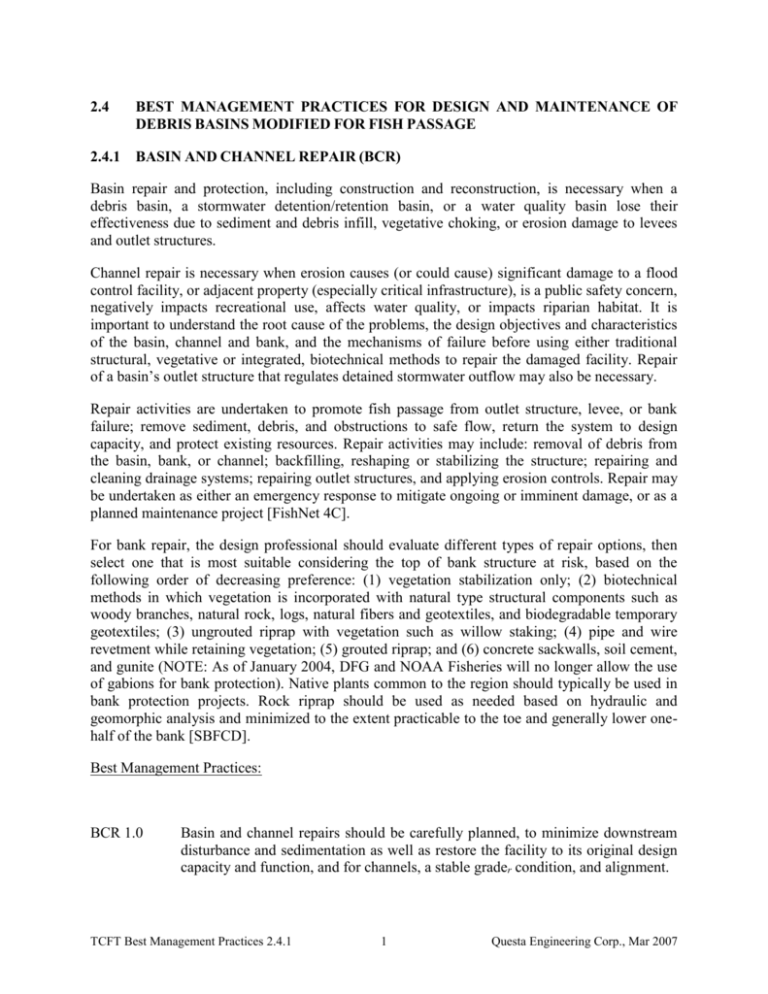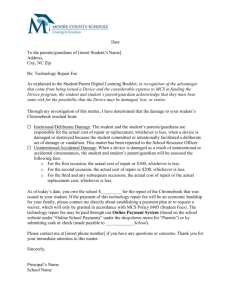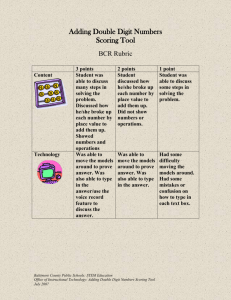BMP 2.4.1 Basin and Channel Repair
advertisement

2.4 BEST MANAGEMENT PRACTICES FOR DESIGN AND MAINTENANCE OF DEBRIS BASINS MODIFIED FOR FISH PASSAGE 2.4.1 BASIN AND CHANNEL REPAIR (BCR) Basin repair and protection, including construction and reconstruction, is necessary when a debris basin, a stormwater detention/retention basin, or a water quality basin lose their effectiveness due to sediment and debris infill, vegetative choking, or erosion damage to levees and outlet structures. Channel repair is necessary when erosion causes (or could cause) significant damage to a flood control facility, or adjacent property (especially critical infrastructure), is a public safety concern, negatively impacts recreational use, affects water quality, or impacts riparian habitat. It is important to understand the root cause of the problems, the design objectives and characteristics of the basin, channel and bank, and the mechanisms of failure before using either traditional structural, vegetative or integrated, biotechnical methods to repair the damaged facility. Repair of a basin’s outlet structure that regulates detained stormwater outflow may also be necessary. Repair activities are undertaken to promote fish passage from outlet structure, levee, or bank failure; remove sediment, debris, and obstructions to safe flow, return the system to design capacity, and protect existing resources. Repair activities may include: removal of debris from the basin, bank, or channel; backfilling, reshaping or stabilizing the structure; repairing and cleaning drainage systems; repairing outlet structures, and applying erosion controls. Repair may be undertaken as either an emergency response to mitigate ongoing or imminent damage, or as a planned maintenance project [FishNet 4C]. For bank repair, the design professional should evaluate different types of repair options, then select one that is most suitable considering the top of bank structure at risk, based on the following order of decreasing preference: (1) vegetation stabilization only; (2) biotechnical methods in which vegetation is incorporated with natural type structural components such as woody branches, natural rock, logs, natural fibers and geotextiles, and biodegradable temporary geotextiles; (3) ungrouted riprap with vegetation such as willow staking; (4) pipe and wire revetment while retaining vegetation; (5) grouted riprap; and (6) concrete sackwalls, soil cement, and gunite (NOTE: As of January 2004, DFG and NOAA Fisheries will no longer allow the use of gabions for bank protection). Native plants common to the region should typically be used in bank protection projects. Rock riprap should be used as needed based on hydraulic and geomorphic analysis and minimized to the extent practicable to the toe and generally lower onehalf of the bank [SBFCD]. Best Management Practices: BCR 1.0 Basin and channel repairs should be carefully planned, to minimize downstream disturbance and sedimentation as well as restore the facility to its original design capacity and function, and for channels, a stable grader condition, and alignment. TCFT Best Management Practices 2.4.1 1 Questa Engineering Corp., Mar 2007 A. Where a contractor has been hired to complete debris basin modifications or maintenance, the leading agency should direct the contractor to use the BMPs outlined in this document. B. When modifying existing debris basins for fish passage, the following guidelines should be followed: a. Modified basins should be designed to minimize the pile up of debris within the portion of the structure designated for fish passage. b. Modified basins should be designed to allow for the downstream passage of fine sediment. c. Debris basin modification in steep coastal watersheds is a new practice and desired results are not guaranteed. A basin may need to be modified again after a few years if it is not operating as expected or required for flood control or fish passage purposes. BCR 2.0 Set up work and staging areas to minimize the area of soil that will be disturbed and the tracking of soil out of the work area by vehicles and equipment. Avoid staging projects in areas where runoff will be concentrated or may run into a watercourse [FishNet 4C]. BCR 3.0 The location of staging and mobilization areas, access points, any work sites and crossings, must be designated and approved in advance to ensure minimization of impacts to wetlands, riparian vegetation and wildlife, and must be coordinated with the contractor to manage heavy equipment. The design “footprint” of all facilities including access roads and staging areas should be kept to same approximate size. BCR 4.0 The operator should minimize the amount of area being graded at a site at any onetime, and should likewise minimize the time that an area is laid bare. Erosion control stabilization and revegetation should be completed immediately following repair operations, according to an approved planting plan, or where required, a Habitat Mitigation and Monitoring Plan. BCR 5.0 During repair operations, heavy equipment may need to cross, or work in and near streams or basins. This is permitted only as necessary to complete the repair, and subject to specific protection requirements and regulatory review and approval by agencies with jurisdiction. Where temporary stream crossings and flow diversions are needed, follow appropriate BMPs. The number of channel entry points and crossings should be carefully located, shown on plans, and kept to the minimum needed for access. Channel crossings should be as perpendicular to stream courses as possible. Streambank excavation should be kept to the minimum needed for use of the crossings. Temporary fords and crossings hardened with washed rock, concrete planks, slabs or geogrids are sometimes an acceptable alternative, depending on water quality, fishery and hydrological considerations. Temporary crossing facilities must be removed and the site stabilized prior to the rainy season each year or when the crossing is no longer needed, which ever is earliest. TCFT Best Management Practices 2.4.1 2 Questa Engineering Corp., Mar 2007 BCR 6.0 Follow BMPs for temporary streamflow diversion where appropriate. Prepare a Water Diversion Plan for review with contractors and regulatory agencies where appropriate. Project location, bypass design, and any mitigation measures are subject to regulatory review and approval by agencies with jurisdiction. If work is to be conducted in ponded or flowing water, the work area should be isolated and the water temporarily diverted around the work site at an appropriate rate to maintain downstream flows during construction. Adequate water depth and channel width must be maintained at all times to allow for fish passage. If sump pools and pumps are needed, they must be equipped with screens to prevent entrainment of aquatic macro-organisms. Barriers such as temporary coffer dams, and construction of barriers contribute to the stream’s sediment loading and turbidity. When construction is completed, the barriers need to be removed in a manner that will allow flow to resume with least disturbance to the substrate. Fish shall not be trapped or isolated within the barriers [PIR]. BCR 7.0 Inspect all construction equipment daily for leaks, loose and worn hoses and fittings, damage, and buildup of oils and grease prior to performing work; and perform maintenance at designated repair facilities. If equipment must be refueled in the field, perform fueling in identified staging areas well away from stream or riparian areas and maintain an absorbent spill kit [FishNet 4C]. BCR 8.0 Implement appropriate Erosion Control, Water Management, and Water Quality Protection/Sediment Control BMPs (refer to Sections 2.2.6 and 2.2.8) during bank repair [FishNet 4C]. BCR 9.0 Prioritize biotechnical repairs versus riprap protection or other hardscape repairs if hydraulic and geomorphic conditions allow. Consult with qualified engineering and environmental services staff if you have questions about when biotechnical repairs can be used instead of hardscape repairs. Engineering staff should confer with planning staff to verify that all appropriate options have been evaluated [FishNet 4C]. BCR 10.0 When installation of riprap or other hardscape repairs are required to protect structures in emergencies or due to hydraulic and geomorphic unstable conditions [FishNet 4C]: A. Place hardscape protection below the ordinary high water mark unless detailed hydraulic/geomorphic analysis and at risk top of bank infrastructure indicate otherwise; B. Toe into bed and key into the bank at upstream/downstream ends (at stable points), as appropriate; and C. Consult with qualified engineering or environmental services staff about the appropriate size of hardscape protection needed, the appropriate placement techniques, and the potential usage of biotechnical protection in conjunction with the hardscape protection. TCFT Best Management Practices 2.4.1 3 Questa Engineering Corp., Mar 2007 BCR 11.0 Dispose of spoils according to procedures discussed in Fill and Spoils BMPs (Section 2.2.3). Treat bermed areas (earthen berms, asphalt bers, sandbag berms, etc.) as temporary disposal sites only, unless needed for drainage control, traffic delineation or as a traffic barrier, and stabilized by planting and other Upslope Erosion Control BMPs (refer to Section 2.2.6) [FishNet 4C]. BCR 12.0 For Biotechnical BMPs (refer to Section 2.2.6) that require the establishment of vegetative cover; plan and implement ongoing vegetation maintenance, reseeding and replanting and irrigation as needed [FishNet 4C]. BCR 13.0 After completion of construction, prepare an As-built Plan, (a post construction permanenet erosion control plan) and monitor the performance of long-term BMPs periodically, particularly after significant storm events. Perform immediate repairs or upgrades as necessary. When excavating slide material, minimize the size of the disturbed area by removing only the amount of slide debris needed to prevent future slope failure and delivery of material to the stream [FishNet 4C]. TCFT Best Management Practices 2.4.1 4 Questa Engineering Corp., Mar 2007





